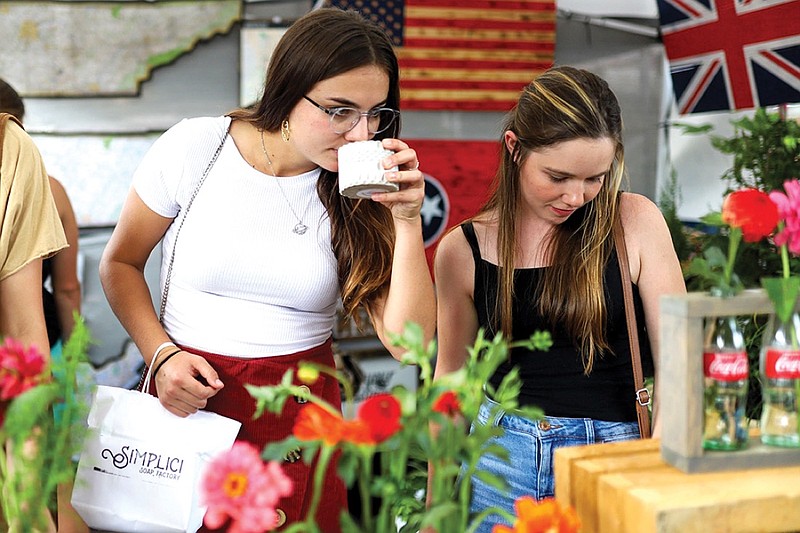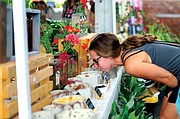The New Salem Mountain Festival returns Oct. 8-9 after a three-year hiatus due to COVID.
When New Salem was last held in 2019, gas in Tennessee averaged $2.53 a gallon. Now it averages $3.88 a gallon.
Will those higher prices keep New Salem fans from driving to the little community atop Lookout Mountain?
Gas cost is one of several concerns festival organizers and vendors face as they grapple with challenges posed by rising inflation.
Craftspeople are searching for discounts and other ways to control the rising costs of their materials. According to an article in Craft Industry Alliance, the pandemic “closed ports, grounded commercial planes and furloughed truck drivers and cargo employees. As a result, bottlenecks formed along supply chains making higher freight storage costs and increasing demand for supplies. Which, in turn, trickled down to higher costs for shoppers.”
Local crafters and festival directors recently explained how they are looking for ways to cope that make “cents.”
THE COST OF DOING BUSINESS
Textile vendors are feeling inflation’s pinch in their wallets this season. The price of wool has increased 4.5% since the beginning of this year. Quilters are dealing with an increase in the price of fabric — anywhere from 2.5 to 10% higher.
Festivalgoers sometimes forget that these vendors aren’t hobbyists looking for a sales outlet for a side hustle. They are small business people, many of whom rely on sales from shows as their primary income.
Christie Gobble launched Kettle Creek Designs in 2015 with wooden home decor items. She works four or five shows a month from March to December.
The cost of wood started climbing in 2020 and has since doubled from last year. As of August, the average price of a 10-foot 2x4 board was $7.65, according to fortune.com.
“Normally I bought wood as I needed it; now I try to stock up on wood when I can find it at reasonable prices,” Gobble says. “My aim is to keep prices reasonable, a price that I can afford, too. When the price of wood went up, people weren’t willing to pay higher prices. I had to revamp the line, and I added a candle line and landscaping plants and trees. There seems to be a market for that.”
Photo Gallery
Organizers and craftspeople look for ways to overcome higher costs that makes sense and cents
She’s found festivalgoers are still buying, “but not the expensive items like before the pandemic.”
Cindy Lowery of Cindy’s Clay Creations also has changed her method of purchasing materials. Since launching her line of polymer clay figurines and personalized Christmas ornaments in 2001, Lowery has developed a faithful following who come to Ketner’s Mill Country Fair every year to add her newest designs to their collections. Her brand is her livelihood, and she works two to three large festivals each year plus sells in three retail outlets.
“Clay has gone up anywhere from 5 to 20% depending on the brand and supplier,” Lowery says. “The COVID shutdown resulted in a national clay shortage, so instead of placing two or three large orders per year, I’m having to source certain colors where I can find them. This has resulted in multiple smaller orders resulting in multiple shipping charges. The cost of packaging has also increased.”
Lowery says when she learned Hobby Lobby recently got a new shipment, she purchased 126 bars of clay at $2.99 each to help her get through the upcoming seasonal demand.
“I tried not to raise prices for a long time, but I’ve gone up about 10%,” she says.
FEE OR FREE?
Day trips to fairs and festivals in photo-worthy autumn settings have long been a source of free, or nominally inexpensive, family fun. Now organizers are facing whether to raise admission fees to make a profit.
Faye Nichols says New Salem will not raise its $5 entrance fee this comeback season.
New Salem is held to raise funds for the community center and volunteer fire department. Money is made from entrance and vendor fees, which cover show expenses. All manpower is free provided by volunteers so that all profits can go back into the community services.
“Our funds have gotten low because of not having the festival for two years. But we didn’t even talk about raising fees because as long as we can stay stable, we don’t want to hold anybody up,” Nichols explains.
Organizers of Sunflower Stables Barn Sale say booking their venue in advance kept that mid-September festival free to the public.
“We had already agreed on our fee last year,” says Margaret Long, who directs Sunflower Stables with Dianne Mason. “We did not increase our vendor fees because our rental fee did not increase. Next year might be different.”
Two North Georgia events did go up on admission this month.
The Georgia Apple Festival in Ellijay, Oct. 8-9 and 15-16, has doubled its admission from $5 to $10. Prater’s Mill Country Fair, Oct. 8-9, increased from $7 to $10.
“The cost of everything is going up,” says Prater’s Executive Director Mikey Sims, “power, water, garbage disposal, printing, portalets.”
But he points out that paying an even $10 will cut down the wait in line at the fair’s gates.
“It will speed up the line because it is easier to make change, no more counting ones.”
Prater’s Mill admission will be cash only, and Sims says ATMs will be placed outside the fair gates for visitors’ convenience. There will be no online ticket sales this year. All proceeds from the fair are used in maintenance and preservation of the historic mill.
The ninth annual Bird & Barn sale, Oct. 14-15, is a fundraiser for nonprofit Project Free2Fly. The nonprofit nurtures and empowers women by teaching them sewing skills to make a living, and the clothing and purses they make are sold at Bird & Barn. Additionally, every woman in the program receives financial provision, counseling services and sewing supplies.
Bird & Barn includes a ticketed evening preview party before opening to the public the following day. Hailey Johnston of Project Free2Fly says their committee made the decision last year to up the preview party to $50 and the event-day ticket to $12. Their foresight has prevented an increase this season and kept the event affordable for its customers.
“We use a lot of leather in our products, and fabric and leather have gone up. Even just the timeliness of getting supplies here has had us getting creative and designing more products that are easier to obtain. We buy all our materials from U.S. retailers. We have raised prices a few dollars, and we are always working and refiguring profit numbers on products,” says Johnston.
“Everybody is price sensitive right now,” says Frank McDonald Jr., Ketner’s Mill Country Fair executive director and mill owner. The 45th fair is set for Oct. 15-16, with proceeds from its $7 admission benefiting the maintenance and preservation of the mill.
McDonald says the festival’s biggest expense is staffing all the aspects of putting on the fair for two days, for which he makes a sizable contribution to Marion County High School. There is also the expense of portalets, cornmeal and grits sold at the mill, ongoing repairs and maintenance of the dam, mill and sawmill.
“We talked about increasing admission, but I didn’t want to,” he says. “We’ll make a little less money this year, but I wanted everyone to feel comfortable about coming to the fair,” he says.

